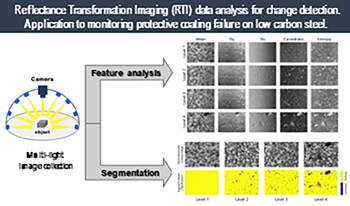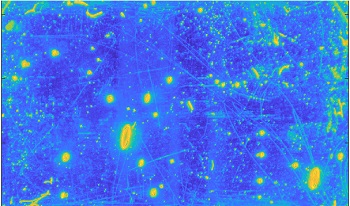
This paper examines two new methodological approaches exploring Reflectance Transformation Imaging (RTI) data processing for detecting, documenting, and tracking surface changes. The first approach is unsupervised and applies per-pixel calculations on the raw image stack to extract information related to specific surface attributes (angular reflectance, micro-geometry). The second method proposes a supervised segmentation approach that, based on machine learning algorithms, uses coefficients of a fitting model to separate the surface’s characteristics and assign them to a class. Both methodologies were applied to monitor coating failure, in the form of filiform corrosion, on low carbon steel test samples, mimicking treated historical metal objects’ surfaces. The results demonstrate the feasibility of creating accurate cartographies that depict the surface characteristics and their location. Additionally, they provide a qualitative evaluation of corrosion progression that allows tracking and monitoring changes on challenging surfaces.

Reflectance Transformation Imaging (RTI) is a multi-light imaging technique using a camera on a fixed position and orthogonal to the studied surface, while varying the light position for each image captured. This allows for the reconstruction of a surface's visual appearance and the characterization of the surface by providing additional information on surface deformations and local micro-geometry. RTI was applied on historical model glass corroded in the presence of volatile organic compounds (VOCs) to visualize early stages of corrosion. RTI was used to create relighting visualizations and generate maps based on statistical descriptors derived from the local reflectance distribution of the pixels. Selected maps were able to assist in the quantification of corrosion signs i.e., fine cracks and salt neocrystallizations (SN), on a more global scale as compared to digital microscopy (DM). Therefore, RTI could provide an imaging solution for the characterization of corrosion signs on transparent colourless glass surfaces, which could not be visualized using simple RGB photography neither with transmitted nor reflected light.

Reflectance Transformation Imaging (RTI) is a computational photographic method that captures an object’s surface shape & color and enables the interactive re-lighting of the subject from any direction. RTI model of an object is built from multiple images of it captured by a stationary camera but varying light directions. By changing the direction of the light, the respective micro-geometry of the object is highlighted. The RTI acquisition process is often long, and tedious when it is not automated. It requires expertise to define for each analysed object which are the number and the relevant lighting positions in the acquisition sequence. In this paper, we present our novel Next Best Light Position (NBLP) method to address this issue. The proposed method is based on the principle of a gradient descent allowing in an adaptive and iterative way, to automatically define the most appropriate lighting directions for the RTI acquisition of an object/surface.